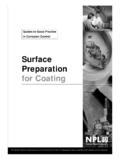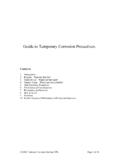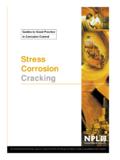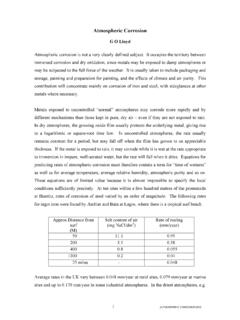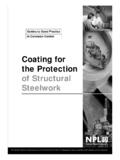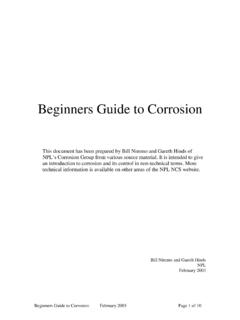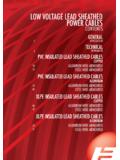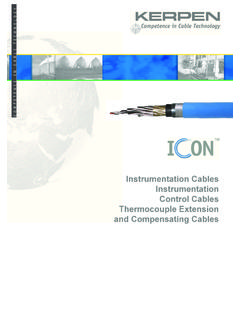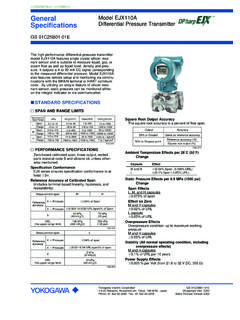Transcription of cathodic protection - National Physical Laboratory
1 cathodic protection This is an update of a DTI publication first issued in 1981. The new version has been prepared by Eur Ing R. L. Kean of ARK Corrosion Services and Mr K. G. Davies, Corrosion Engineer, under contract from NPL for the Department of Trade and Industry. Contents page Introduction 1 History 1 The Principles of cathodic protection 1 Sacrificial anodes 2 Impressed current 2 Advantages and Uses of cathodic protection 2 Pipelines Storage tanks Steel pilings Reinforced concrete Ships
2 Offshore structures Basic Requirements for cathodic protection 3 Design Factors 4 Monitoring and Maintenance 6 Sources of advice 7 Further Information 7 cathodic protection 1 Introduction This Guide describes the basic principles of cathodic protection , the areas of use, and the general factors to be considered in the choice and design of a system. It gives a basic introduction and simple technical data on cathodic protection . Further assistance and information may be gained from organisations listed in Section 10, various independent or commercial consultants, and product suppliers.
3 History The first reported practical use of cathodic protection is generally credited to Sir Humphrey Davy in the 1820s. Davy s advice was sought by the Royal Navy in investigating the corrosion of copper sheeting used for cladding the hulls of naval vessels. Davy found that he could preserve copper in seawater by the attachment of small quantities of iron, zinc or tin. The copper became, as Davy put it, cathodically protected . It was quickly abandoned because by protecting the copper its anti-fouling properties became retarded, hence reducing the streamline of the ships, as they began to collect marine growths. The most rapid development of cathodic - protection was made in the United States of America and by 1945, the method was well established to meet the requirements of the rapidly expanding oil and natural gas industry, which wanted to benefit from the advantages of using thin-walled steel pipes for underground transmission.
4 In the United Kingdom, where low-pressure, thicker-walled cast-iron pipes were used extensively, very little cathodic protection was applied until the early 1950s. The increasing use of cathodic protection in modern times has arisen, in part, from the initial success of the method as used from 1952 onwards to protect about 1000 miles of wartime fuel-line network. The method is now well established and is used on a wide variety of immersed and buried facilities and infrastructure, as well as reinforced concrete structures, to provide corrosion control. The Principles of cathodic protection Metal that has been extracted from its primary ore (metal oxides or other free radicals) has a natural tendency to revert to that state under the action of oxygen and water.
5 This action is called corrosion and the most common example is the rusting of steel. Corrosion is an electro-chemical process that involves the passage of electrical currents on a micro or macro scale. The change from the metallic to the combined form occurs by an anodic reaction: M M+ + e- (metal) (soluble salt) (electron) A common example is: Fe Fe++ + 2e- This reaction produces free electrons, which pass within the metal to another site on the metal surface (the cathode), where it is consumed by the cathodic reaction. In acid solutions the cathodic reaction is: 2H+ + 2e- H2 (hydrogen ions (gas) in solution) In neutral solutions the cathodic reaction involves the consumption of oxygen dissolved in the solution: O2 + 2H2O + 4e- 4OH- (alkali) Corrosion thus occurs at the anode but not at the cathode (unless the metal of the cathode is attacked by alkali).
6 Figure 1. Corrosion cell / Bimetallic corrosion The anode and cathode in a corrosion process may be on two different metals connected together forming a bimetallic couple, or, as with rusting of steel, they may be close together on the same metal surface. This corrosion process is initially caused by: Differerence in natural potential in galvanic (bimetallic) couples. Metallurgical variations in the state of the metal at different points on the surface. Local differences in the environment, such as variations in the supply of oxygen at the surface (oxygen rich areas become the cathode and oxygen depleted areas become the anode). Electron (e-) flow in metal 2M 2M++ + 4e- (corrosion)O2 + 2H2O + 4e- 4OH- cathodic protection 2 2 The principle of cathodic protection is in connecting an external anode to the metal to be protected and the passing of an electrical dc current so that all areas of the metal surface become cathodic and therefore do not corrode.
7 The external anode may be a galvanic anode, where the current is a result of the potential difference between the two metals, or it may be an impressed current anode, where the current is impressed from an external dc power source. In electro-chemical terms, the electrical potential between the metal and the electrolyte solution with which it is in contact is made more negative, by the supply of negative charged electrons, to a value at which the corroding (anodic) reactions are stifled and only cathodic reactions can take place. In the discussion that follows it is assumed that the metal to be protected is carbon steel, which is the most common material used in construction. The cathodic protection of reinforcing carbon steel in reinforced concrete structures can be applied in a similar manner.
8 cathodic protection can be achieved in two ways: - by the use of galvanic (sacrificial) anodes, or - by impressed current. Galvanic anode systems employ reactive metals as auxiliary anodes that are directly electrically connected to the steel to be protected. The difference in natural potentials between the anode and the steel, as indicated by their relative positions in the electro-chemical series, causes a positive current to flow in the electrolyte, from the anode to the steel. Thus, the whole surface of the steel becomes more negatively charged and becomes the cathode. The metals commonly used, as sacrificial anodes are aluminium, zinc and magnesium. These metals are alloyed to improve the long-term performance and dissolution characteristics.
9 Impressed-current systems employ inert (zero or low dissolution) anodes and use an external source of dc power (rectified ac) to impress a current from an external anode onto the cathode surface. The connections are similar for the application of cathodic protection to metallic storage tanks, jetties, offshore structures and reinforced concrete structures. Advantages and Uses of cathodic protection The main advantage of cathodic protection over other forms of anti-corrosion treatment is that it is applied simply by maintaining a dc circuit and its effectiveness may be monitored continuously. cathodic protection is commonly applied to a coated structure to provide corrosion control to areas where the coating may be damaged.
10 It may be applied to existing structures to prolong their life. Specifying the use of cathodic protection initially will avoid the need to provide a corrosion allowance to thin sections of structures that may be costly to fabricate. It may be used to afford security where even a small leak cannot be tolerated for reasons of safety or environment. cathodic protection can, in principle, be applied to any metallic structure in contact with a bulk electrolyte (including concrete). In practice, its main use is to protect steel structures buried in soil or immersed in water. It cannot be used to prevent atmospheric corrosion on metals. However, it can be used to protect atmospherically exposed and buried reinforced concrete from corrosion, as the concrete itself contains sufficient moisture to act as the electrolyte.
